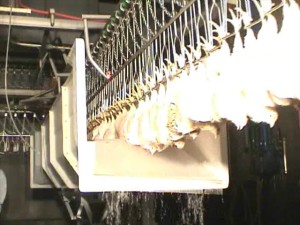What is stunning? How does stunning ensure that chickens are not slaughtered while conscious?
1. Why are birds stunned prior to being slaughtered? In the old days, didn’t grandma just take them out back?
Yes, many backyard-raised birds were slaughtered with an axe and a chopping block. Although swift, this method is not practical for the very large number of birds that are processed on a daily basis. In 1957, the Humane Methods of Slaughter Act included a section regarding poultry. The regulation required that “fowl first be rendered insensible by the severing of the head from the body or by an electrical or other means determined by the Secretary (of Agriculture) to be rapid, effective and humane.” The original stunning systems were installed in Europe in the 1960’s. These systems were all electrical stun systems. Electrical systems positioned the birds in a more consistent posture for the automatic systems that were just being developed. It was later that stunning the birds before slaughter was considered important for welfare of the birds.
2. What are some ways that companies use to stun chickens to induce unconsciousness?

There is one primary method of stunning broilers prior to slaughter in the U.S. and that is “electrical stunning.” It is the predominant method of rendering birds unconscious. There are a limited number of facilities in the U.S. that utilize controlled atmosphere stunning (CAS) systems for broilers. These systems utilize carbon dioxide to render birds insensible. Another CAS system utilizes a reduction of atmospheric pressure to stun birds.
3. Is controlled atmosphere stunning more humane and more effective than low voltage electrical stunning? What are some of the pros and cons of each method?
Most CAS systems render the birds unconscious while still in the transport modules used to transport them from the chicken house to the processing facility. Although stunning the birds in these modules eliminates the stress of unloading and shackling live birds, there is some degree of aversion to the carbon dioxide used to stun the birds. Some birds exhibit open-mouth breathing and a degree of alertness when exposed to the gas and some demonstrate excessive wing flapping which may cause damage that is a meat quality issue.
Electrical stunning creates an instantaneous unconsciousness but requires the birds to be unloaded from the trucks and the shackling of live birds.
4. What kinds of safeguards or regulations are in place to ensure that birds are not slaughtered while conscious? Are there animal welfare regulations to guide the slaughtering practice in the United States?
Processing plants have rigorous welfare requirements that are part of their daily operating procedures. Companies that process animals for food understand that the welfare is important and the right thing to do. Additionally, customers like many of the fast food restaurants, grocers and others have strict requirements that their suppliers have working welfare programs in place. These programs are audited on a regular basis. The USDA inspection service has strict regulations regarding how birds are slaughtered and any deviations are immediately brought to the attention of the plant management.
5. Based on your experience, do chickens experience suffering when they are slaughtered?
We are constantly working to understand what is stressful and how we can reduce stress through the slaughter process. There are procedures in place that minimize any stress and discomfort. The process of transportation and slaughter is getting a lot of attention and that process is under constant review. I am confident that any changes that are necessary will be made as the information becomes available.
6. In addition to ethical concerns, are there economic incentives to making sure the chickens are properly stunned and slaughtered?
We are constantly working to understand what is stressful and how we can reduce stress through the slaughter process. There are procedures in place that minimize stress and discomfort. The process of transportation and slaughter is getting a lot of attention and is under constant review. I am confident that any changes that are necessary will be made as the research becomes available.
7. Do independent researchers frequently visit commercial processing plants? And if so, why?
Processing plants use the best science, technology and equipment to produce a high quality product and to reduce product loss, all while ensuring the optimum welfare of the birds they are processing. Plants regularly invite experts into the plants to evaluate their overall performance or address any new issue that may improve quality. In addition, many researchers are welcomed in plants to look for new ways to improve processes or utilize new equipment. Plants are always striving for continuous improvement.
I have regular opportunities to work with companies that are looking to improve processes and improve bird welfare. I enjoy working with plant personnel because they are interested in learning how to solve problems or add new ideas to improve the process.
8. In your opinion, are the electrical settings used in the U.S. adequate to meet international standards for humane stunning and slaughter of poultry?
I have not seen any indication that a properly operating stun system in the U.S. is inhumane. “Stun to kill” systems used in Europe increase the amount of meat that is trimmed due to broken bones and blood spots. The other consideration is that for some religious slaughter requirements, stun to kill is not acceptable as the birds must still have a heart beat prior to slaughter.
9. Prior to being slaughtered, what are some of the steps companies take to help alleviate stress and pain? Are they effective?
When birds reach market size and are scheduled for processing, there are many systems in place to minimize stress. Birds are caught and transported under strict programs that have been developed to keep the birds comfortable throughout the transport process.
Environmental temperatures are considered and equipment to cool them or keep them warm is used to keep them comfortable. Density on trucks is monitored based on bird size so they have plenty of room while being transported. Holding areas are designed to maintain comfortable conditions prior to processing.
If the stunning system requires the birds to be unloaded, equipment operators make sure the right number of birds are moving into the plant to prevent crowding. Birds are unloaded in reduced light to keep them quiet and minimize stress. Rub bars make gentle contact with the birds while shackled to keep them calm. Equipment in the plant is monitored for each flock and necessary adjustments are made.
10. Is gas stunning more humane? Does gas stunning systems produce consistently superior meat quality?
I am not sure we know enough about these systems to declare that one is more humane than the other. This is an important area that deserves – and is getting – a lot of attention and research. Processors want to make sure that if they need to make changes, they make the correct one for the welfare of the birds and meat quality for the consumers.

Karen Christensen, Ph.D., is an extension poultry specialist/ associate professor at the Center of Excellence for Poultry Science, University of Arkansas, Fayetteville. Karen received her BS and MS in Animal Science at Washington State University and her Ph.D. in Poultry Physiology from Mississippi State University. Karen enjoyed a long career in the broiler industry prior to joining the faculty at the University of Arkansas.
